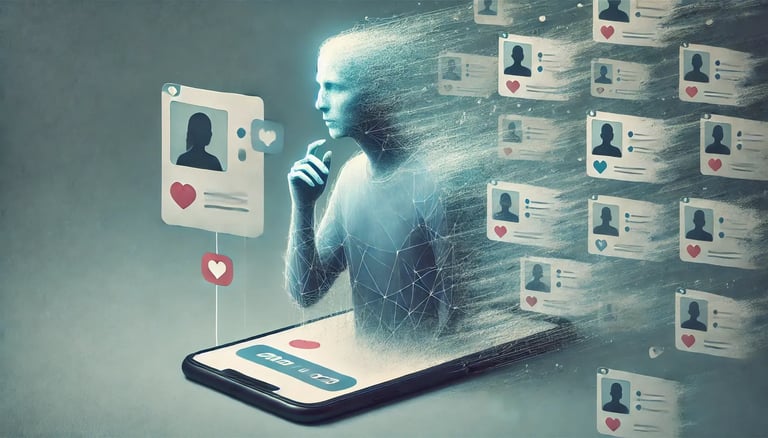The dating economy The cultural phenomenon of ghosting

By Cape Capital
31.10.2024

Dating apps have transformed how we connect, but frustrations are mounting as ghosting and superficial interactions become all too common. With millions paying to find love, a push for more personal, meaningful approaches is emerging, signalling a shift away from digital matchmaking.
How many people do you know who met their partner on a dating app? Chances are, quite a few. Almost one fifth of the EU’s total population are on the apps and there are more than 300 million people using digital dating solutions worldwide. What’s more, at least 20 million global users are willing to shell out cash – paying for subscription fees and to unlock special features – in an attempt to better their chances of finding someone special. In other words? There’s big money in love.
The rise of swipe culture
A lot has changed since Match.com launched as the world’s first online dating website in 1995. The iPhone launched in June 2007, and within two years, Grindr arrived, revolutionising dating and hook-ups for gay men and paving the way for Tinder exploding on the scene in 2012 and infiltrating the mainstream. These days, we’ve embraced the apps as a fundamental part of modern dating: their use is so popular that many Gen Zs can’t even remember them not being around. Inevitably, though, just as our behaviours have changed in tandem with increased screen time more generally – prompting reduced attention spans and scrolling addictions – changes have seeped into the dating world. 'Ghosting' is one of the most common symptoms of online dating in 2024: the act of ending all contact with someone without explanation, often to the upset or bewilderment of the other person. It’s a new issue faced by younger generations looking for love in a globalised, hyper-connected world, who can worry less about the awkward confrontations of bumping into a former love interest at the local pub.
What’s more, ghosting is a product of the apps themselves: because balancing the needs of users with big tech isn’t easy. For-profit tech companies are required to attract as many (ideally paying) users as possible, for as long as possible, but the users – at least the ones who are looking for more than a casual fling – usually don’t want to hang around for long. In the last year, this paradox seems to have come to a head. Back in February, the apps came under fire, with users in California filing a proposed class-action lawsuit against Match Group – which owns Hinge, Tinder, and more than 40 other dating platforms – over their business model. They said that the apps use addictive 'game-like features' to keep users hooked, enticing them to pay for subscriptions and ending up stuck in a cycle of swipes rather than actually finding love. In Hinge’s case, they argued that this model fundamentally contradicted their marketing tagline of 'designed to be deleted.'
A Match Group spokesperson denied the allegations and said in a public statement that the lawsuit was “ridiculous and has zero merit”, but the case certainly started a conversation: it seems users have started to wake up to the realities of dating via the apps. Hayley Bystram is a dating coach and relationship expert and says she’s seen an uptick in people using traditional matchmaking services due to their frustration with the apps. “Part of the motivation is because they feel they just have a load of digital pen pals, and it’s not progressing through a relationship – because it’s not even progressing to meeting in person,” Bystram says.
Avoidance made easy
Bystram suspects the design of the apps themselves will often influence – and even encourage – behaviours like ghosting due to the lack of accountability which comes with setting up a profile. Their non-committal, quick-to-sign-up format – where you input minimal details to set up an account – are designed to onboard as many users as fast as possible, creating a culture of disposability and making choosing avoidance over communication all too easy. “Why would you put the hard work into explaining yourself why you left too long to reply to someone, when you [just] received an email with the ten hottest people this month and you can pick one of those instead?” Bystram says.
“The apps create this situation where there is no consequence and possibility of confrontation. It appeals to that immediacy culture where we get accustomed to quick responses and instant gratification.”
Of course, ghosting isn’t always intentional – Bystram believes it’s sometimes a by-product of a wider issue of digital overwhelm – but for the most part, the apps aren’t helping.
Let’s take a closer look at an app like Hinge, which has a 'freemium' business model. Users can access the basic features for free, but to get extra perks, like a higher visibility profile and being able to send more likes, you’ll have to pay (Hinge Premium costs 23.99 CFH a month).
.webp?width=1792&height=1024&name=%233%20(3).webp)
Just like other apps, there are sneaky strategies embedded in the design to get people to pay for premium features. One is a ranking system: the algorithm will 'rank' your profile photos when you join the platform and adjust it based on the users who swipe right or left on you. If someone who’s deemed very attractive likes you, your rating goes up, and, if someone who’s judged to be less attractive rejects you, then your rating goes down. The app will then limit the amount of people it shows you who are determined to be in your rank, in an effort to tempt you to pay for a subscription to access better matches.
Most dating apps give free users a set amount of swipes per day, but some users have reported running out of swipes immediately before being shown the most attractive person they’ve seen all day. Others have reported seeing more desirable matches behind the 'paywall' and even being blocked from matching with users who had already swiped right for them, unless they cash out. “The worst thing the apps can do is match people, because then they would both cancel their subscription – if you do that with 10,000 people, that’s a hell of a lot of money,” explains Bystram. So, the best thing they can do is keep you subscribing, keep you paying monthly, and keep the dopamine hits coming.
A pushback against the apps
All this said, it’s almost no surprise we’ve started to see a real push-back to the apps this year. In London, speed-dating events have become 'cool again', with events popping up left, right and centre: incorporating singles mixers with the likes of supper clubs or vinyl listening parties. A recent (and somewhat more bizarre) trend caught on in Spain, where singles would head to the supermarket between 7pm and 9pm and go to the wine aisle with an upside down pineapple in their trolley: the idea being that if you bump trolleys with another pineapple, you’re both interested. Elsewhere, people are taking tech into their own hands, like setting up bespoke Google Forms to sift through potential suitors.
In the backdrop of all of this, shares of Match Group, which boasts 50 percent of the global market for dating apps, have fallen by almost 70 percent between its IPO in the summer of 2020 and June this year. Meanwhile, shares at Bumble were down 85 percent from its 2021 market listing. They’ve listed slowing growth, with monthly app downloads falling, as well as reputational issues. So is it time we stopped swiping right for the apps? With 6.1 million monthly downloads of Tinder in June alone, it seems we won’t be waving goodbye just yet. As the smartphone generation ages and algorithmic technologies continue to grow, behaviours like ghosting could become so entrenched in normality we might not even notice them – or, one might hope, we’ll learn to approach love with a little more humanity.